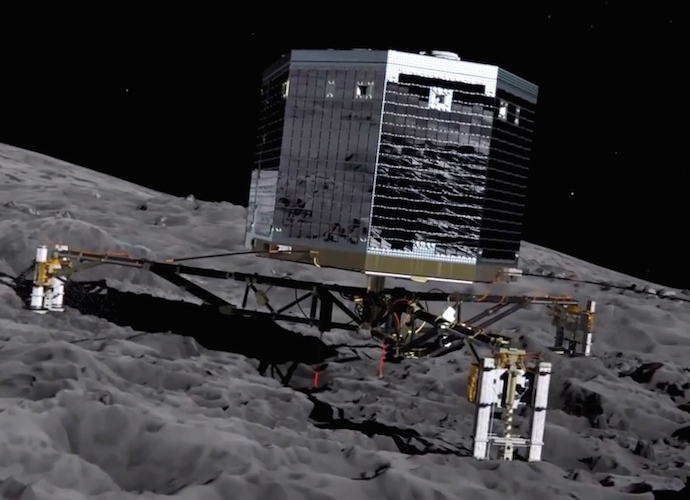After Philae Successfully Lands On Comet 67P, Its Harpoons Fail To Deploy
Philae Lander successfully landed on Comet 67P Wednesday, after a few technical problems delayed the final landing, making it the first successful landing on a comet.
Philae Lands On Comet 67P
European Space Agency (ESA) began the Rosetta mission a decade ago, and has finally released the Philae Lander from its connection to the Rosetta spacecraft. Early Wednesday morning, Philae was released and slowly embarked on its trajectory to the comet, named Comet 67P. Should Philae and Rosetta be successful, Philae will explore the surface of the comet, gathering data on chemical composition, among other things, while Rosetta circles the comet, accompanying it on its trajectory for one year.
SEPARATION CONFIRMED! Safe journey @Philae2014! pic.twitter.com/dsM5Xaedzp
— ESA Rosetta Mission (@ESA_Rosetta) November 12, 2014
The Philae Lander appeared to successfully land on Comet 67P, but had some difficulties when it reached the surface of the comet. Philae was equipped with harpoons meant to anchor the lander to the comet and keep it firmly on the surface. This is due to the comet’s low gravitational pull. Unfortunately, the harpoons failed to deploy correctly, leaving Philae floating a bit, in what scientists are calling a “bounce” or “second landing.”
“So maybe we didn’t land once – we landed twice,” said Philae Lander manager Stephan Ulamec after the landing. Ulamec added that, despite the issue with the harpoons, Philae appeared to be working well so far. “We had a very clear signal there, we received data from the landing – housekeeping and science data – that’s the good news,” Ulamec told reporters.
TOUCHDOWN for @Philae2014! #CometLanding pic.twitter.com/ZMBeB8ng3h
— ESA Rosetta Mission (@ESA_Rosetta) November 12, 2014
Philae Harpoons Fail To Deploy
Though the Philae Lander appears to have stabilized on the surface of Comet 67P, scientists must now determine whether or not to re-deploy the harpoons when they are able to reconnect to the Philae Lander on Thursday.
I’m on the surface but my harpoons did not fire. My team is hard at work now trying to determine why. #CometLanding — Philae Lander (@Philae2014) November 12, 2014
More analysis of @Philae2014 telemetry indicates harpoons did not fire as 1st thought. Lander in gr8 shape. Team looking at refire options
— ESA Operations (@esaoperations) November 12, 2014
#CometLanding
Meanwhile, people around the world are congratulating ESA on Twitter, using the hashtag “#CometLanding,” and Philae Lander has already managed to send out images of the surface of the comet. “We had a very clear signal there, we received data from the landing – housekeeping and science data – that’s the good news,” added Ulamec.
“We are extremely happy. To get the signal it had touched the surface was a major achievement – it was quite extraordinary. Philae is already taking measurements, sniffing the comet,” ESA lander system engineer Laurence O’Rourke told CNN.
“With Rosetta we are opening a door to the origin of planet Earth and fostering a better understanding of our future. ESA and its Rosetta mission partners have achieved something extraordinary today,” said ESA Director General Jean-Jacques Dordain.
“That comet is the most bizarre, wonderful thing I have ever seen. Those images have just blown me away. Philae was such a huge success before it even did anything, so kudos to ESA and the scientific community. No one has ever gotten data like Rosetta has gotten. No one has ever been able to land on a comet the way Philae just did,” said NASA chief scientist Ellan Stofan.
.@ESA_Rosetta See for yourself! ROLIS imaged #67P when we were just 3km away! Glad I can share. #CometLanding pic.twitter.com/b6mcid2fsn — Philae Lander (@Philae2014) November 12, 2014
RELATED ARTICLES
Get the most-revealing celebrity conversations with the uInterview podcast!









Leave a comment